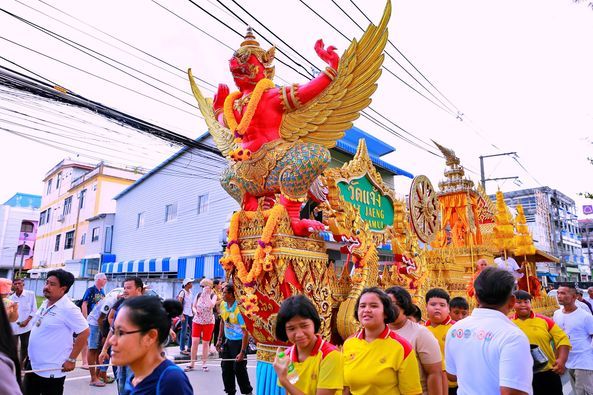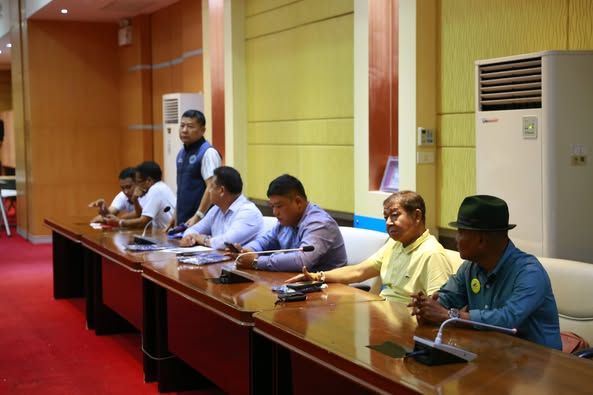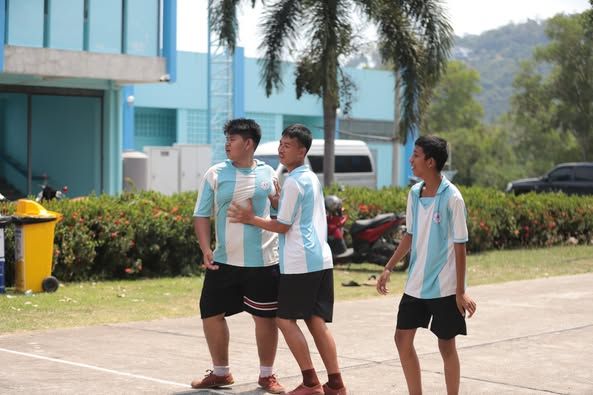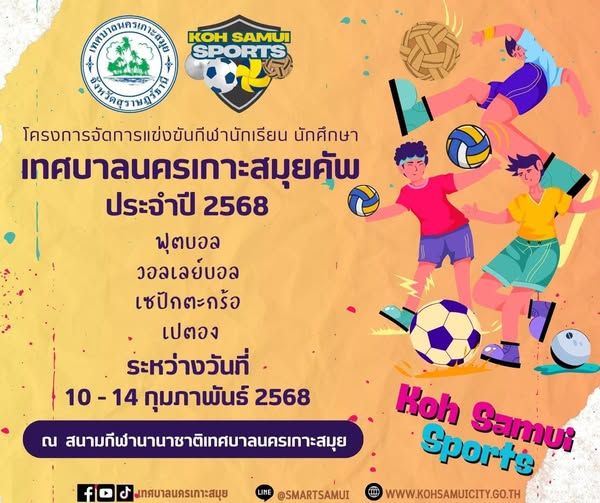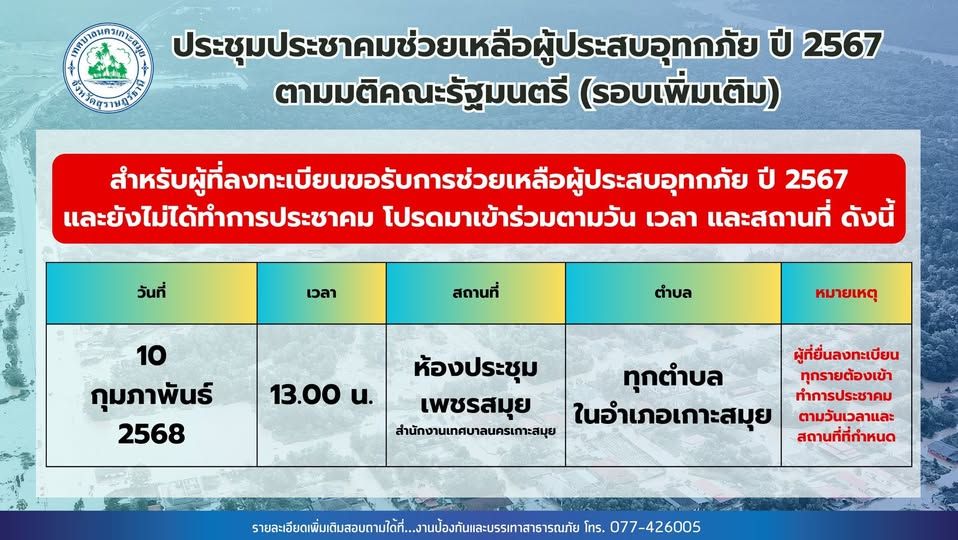🌺📿 Experience the enchanting Robe Offering Festival on stunning Koh Samui! Join the vibrant parade and witness the locals welcoming Lord Buddha back from Tavatimsa heaven with fabric cloth. Don’t miss out on this beautiful cultural heritage experience! 🌟 #KohSamui #RobeOfferingFestival #CulturalHeritage #Traditions #BuddhistLent #ThaiCulture #Thailand #FestivalFun #TravelGoals
The island of Koh Samui, with its natural beauty and rich cultural heritage, is home to a unique tradition known as the Robe Offering Festival. This event takes place annually and coincides with the end of Buddhist Lent, a period of intense spiritual practice for Buddhists.
The Ceremony: A Blend of Devotion and Celebration
The Robe Offering ceremony, locally known as ‘the Chak Phra‘, is deeply ingrained in Southern Thai culture. It’s a day of merit-making that falls on the full moon of the 11th lunar month. The event commemorates the return of Lord Buddha from Tavatimsa heaven, where he completed a period of preaching to his mother.
On this auspicious occasion, local Buddhists gather in large numbers to welcome him. A key part of the ceremony involves inviting the Lord Buddha to sit on a fabric cloth, which is then carried in a vibrant parade around the city.
Historical Roots of the Festival
The roots of the Robe Offering ceremony can be traced back to ancient India. During various occasions, locals would parade deities through their communities, a practice that gained significant popularity. As Buddhism spread, this tradition was adapted and realigned with Buddhist beliefs and teachings.
According to Buddhist lore, Lord Buddha once performed miracles at the Mango Grove in Savatthi before journeying to Tavatimsa heaven. There, he preached to his mother, who had been reborn as Maha Maya Deva in Tusita heaven. During the Lent period, Buddha expounded on the virtues of gratitude towards mothers and taught seven books of Buddhist doctrines.
The Return from Heaven
On the last day of the Lent, Lord Buddha descended back to the human realm. His path was a ladder offered by Indra, extending from Mount Sineru in Tusita heaven to the gate of Sankassa city. The ladder had three parts: a golden ladder for gods on Buddha’s right, a silver ladder for Brahma on his left, and a central crystal ladder for Buddha himself.
Buddha arrived at Sankassa city at dawn on the full moon of the 11th lunar month, marking the end of Lent. A large gathering of Buddhists who were informed of his return by Moggallana, a chief disciple of Buddha, awaited him. Along with their warm welcome, they had brought food offerings with them.
A Tradition Born
Due to the sheer number of attendees, not everyone could present their offerings directly to Buddha. Instead, they had to pass the offerings wrapped in leaves down the line to reach him. Some who were too far even resorted to tossing their offerings towards Buddha’s collection bowl. This act of ‘wrapping and flinging’ food became an integral part of the festival, symbolizing the joy at Buddha’s safe return.
The event concluded with the Buddhists inviting Buddha to sit on a fabric cloth or ‘Bhusabok’. They had prepared this cloth with much reverence and paraded it around as a mark of respect and adoration. With the advent of Buddha statues, they began to be used in these processions as a symbol of Lord Buddha himself, adding yet another deeply meaningful tradition to this remarkable festival.
The Koh Samui Robe Offering Festival is more than just an event. It’s a testament to the deep-rooted faith and vibrant cultural heritage of the Southern Thai community. So if your journey takes you to Koh Samui during this festival, do take the time to experience this beautiful blend of devotion and celebration.
Frequently Asked Questions
What is the Koh Samui Robe Offering Festival?
The Robe Offering Festival, known locally as ‘the Chak Phra’, is a significant traditional event that takes place annually on the island of Koh Samui. The festival commemorates the return of Lord Buddha from Tavatimsa heaven, where he had been preaching to his mother. As part of the celebration, local Buddhists invite the Lord Buddha to sit on a fabric cloth and then carry it in a parade around the city. This festival is marked with deep devotion and celebration, reflecting the vibrant cultural heritage of the Southern Thai community.
Why is the act of ‘wrapping and flinging’ food significant during the festival?
The act of ‘wrapping and flinging’ food originated when Lord Buddha descended back to the human realm at the end of Lent. A large gathering of Buddhists were present to welcome him, bringing food offerings. Due to the vast number of attendees, many couldn’t present their offerings directly to Buddha, and so they began to pass the offerings wrapped in leaves down the crowd. Some even resorted to tossing their offerings towards Buddha’s collection bowl. This act became an integral part of the Robe Offering Festival, symbolizing the joy at Buddha’s safe return.
How does the ‘Bhusabok’, or fabric cloth, play a role in the festival?
The ‘Bhusabok’ is a fabric cloth prepared with much reverence by the Buddhists. At the end of the festival, they invite Buddha to sit on this cloth, symbolizing their respect and adoration. It is then paraded around the city. Over time, Buddha statues began to be used in these processions as a symbol of Lord Buddha himself, adding an even deeper layer of meaning to this tradition. The ‘Bhusabok’ is a key part of the Robe Offering Festival, reflecting the deep-rooted faith and vibrant cultural heritage of the Southern Thai community.
